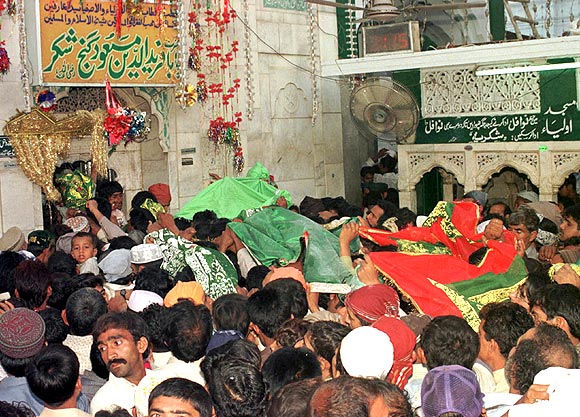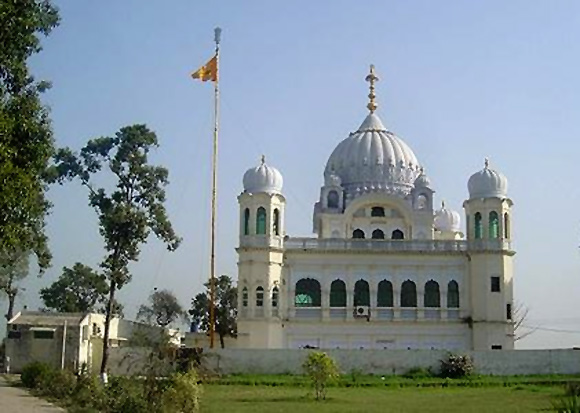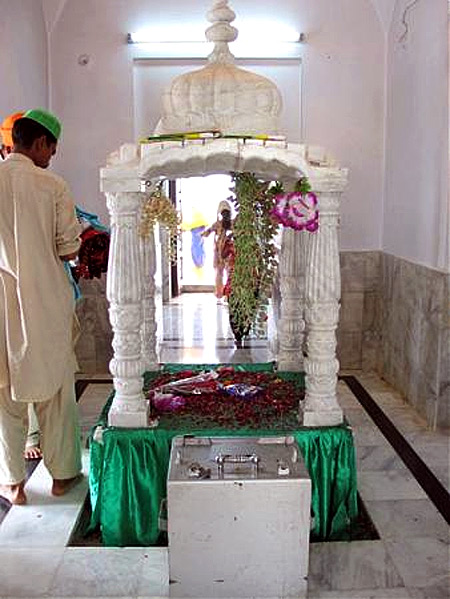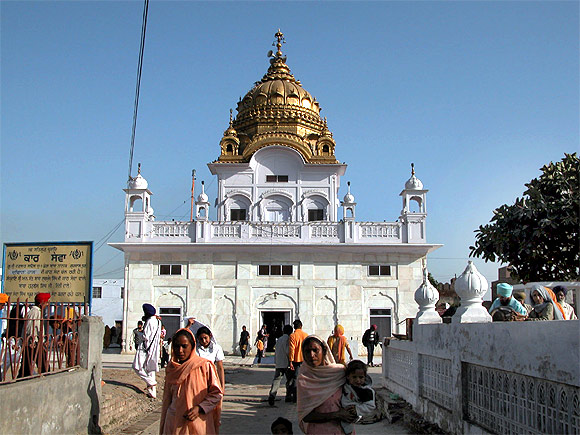 | « Back to article | Print this article |
'Kartarpur Sahib in Pakistan is like Medina to us'
In the third of his four-part series that gives a Pakistani perspective on India's politics, society and economy, Amir Mateen recalls an Indian Sikh's lament, "Why does Pakistan not allow us to visit Kartarpur Sahib? It's like Medina to us, the holiest of holy places; how would you feel if Muslims are not allowed to visit Medina or Christians stopped from visiting Jerusalem or the Vatican?"
Don't miss Part I: 'Indian morality is not threatened by what women wear'
Part II: Lahore, Amritsar: Once sisters, now strangers
A visit to the Golden Temple in Amritsar is always a spiritual experience.
The Pakistani contingent of parliamentarians on a visit to Amritsar was lucky to have arrived on the solemn occasion of the Guru Granth Sahib's birthday.
The Golden Temple looked like a diamond temple because of the lights and fireworks.
Thousands of devotees had come from all over India's Punjab, perhaps the world, to pay their respects.
People stood in the queue, the prasad of halwa on leaves in their hands, for hours.
The Pakistani contingent was extended the special privilege of darshan inside the Harminder Sahib.
Men, women, old and young, stood calmly in a very long queue in the suffocating, humid weather, something that member of the National Assembly Rasheed Godel acknowledged, given the near-Nazi standard of discipline in his party, the Muttahida Quami Movement.
Everybody gave way, breaking the line, when our hosts whispered, "Pakistani guests."
And always with a smile, as if they knew us.
Click on NEXT to read more...
The mesmerising magic of the Granth Sahib
We were also allowed to stay for some time inside the temple right in the middle of the holy pond.
The mellow recitation of the Granth Sahib in the background had a mesmerising effect.
I was informed by a devotee that the recitation was from Baba Farid Shakarganj's verses which are part of the Granth Sahib.
Senator Saif Magsi asked me if I understood the recitation.
I told him Baba Farid is the first acknowledged Punjabi Sufi poet from the twelfth century, which is 300 years before Elizabethan English, but I could generally understand its spirit.
"Do you know Baba Farid's shrine is in Pakpattan?" the devotee, who introduced himself as Kharak Singh, asked.
I told him we had with us a member of our national assembly from Pakpattan, Mansab Dogar. He looked at Dogar reverently, as if he was the avatar of the great Sufi.
Click on NEXT to read more...
A bridge between Muslims and Sikhs
Kharak Singh was trying to make us comfortable and in the process building a bridge between Muslims and Sikhs.
He went on to tell us that Guru Nanak had performed a Hajj and that he is buried in Kartarpur Sahib.
Guru Nanak's teachings are all from Kartarpur where he spent the last 20 years of his life.
When he passed away on the banks of the River Ravi, Muslims and Hindus argued over his faith.
The Hindus said he was one of them because he was born as such, whereas the Muslims argued he was closer to Islamic beliefs and that he had also performed Hajj.
The legend goes that while they were fighting, a storm broke out and they found only flowers under the chaddar (shroud) instead of the Guru's body. He is half buried, half cremated in Kartarpur.
Kharak Singh asked me if I knew where Kartarpur in Pakistan was. I told him I knew it very well because of my closest friend Chaudhary Anwer Aziz.
Kartarpur is in Shakargarh from where Chaudhary Sahib and his son Danial have been elected many times. In fact, I was part of his initiative to donate a few peacocks to Kartarpur.
"You know, Guru Nanak liked peacocks around his farm in Kartarpur," this was my turn to educate Kharak Singh.
"Why does Pakistan not allow us to visit Kartarpur Sahib?" he shot back. "You see, it's like Medina to us, the holiest of holy places; how would you feel if Muslims are not allowed to visit Medina or Christians stopped from visiting Jerusalem or the Vatican?"
I had no answer.
Click on NEXT to read more...
Sikhs yearn to see Kartarpur Sahib at least once in their life
Not many people in Pakistan know about Kartarpur.
Sikhs all over the world yearn to see it at least once in their life.
The problem is that it is located right on the banks of the Ravi, where the meandering river is the border, a mere stone's throw away from India. Hence, it is a restricted 'security area.'
For decades, Kartarpur was locked-away 'evacuee' property.
Indian Parliamentarian Manohar Singh Gill protested about that when he was taken there by Chaudhary Aziz.
"How can you call it an evacuee property; it gives the impression as if it has no heirs!" he said.
"True, but it is better than the 'enemy property' that you call Muslim places in India," I recall Chaudhary Aziz responding.
Kartarpur, a very humble structure, perhaps in keeping with Guru Nanak's humility, fell into disrepair. Chaudhary Anwer Aziz was one of the biggest champions who helped open it up, at least for a very restricted community.
I was also part of the initiative for the legislation, when Chaudhary Shujaat was the prime minister, which got Pakistani Sikhs some autonomy to run their holy places.
Incidentally, the legislation for the Shiromani Gurdwara Parbandhak Committee, which oversees gurdwaras in India, was drafted by none other than Mohammad Ali Jinnah.
But we have so far failed in our efforts to allow at least a corridor across the Ravi so that Indian devotees can visit their Kartarpur.
Click on NEXT to read more...
They shed a few tears and go back home in misery
Meanwhile, thousands of devotees go to Dera Baba Nanak across the river in India, bow in the mud facing Kartarpur, shed a few tears and go back home in misery.
One can actually see the longing in their eyes from the roof top of Kartarpur... so near and yet so far away.
Manohar Gill lamented that Sikhs are the only people in the world who are denied free and liberal access to their Mecca-Madina. 'The indifference on both sides has given this punishment to the Sikhs after Partition,' he wrote in a blog recently.
It is here in Amritsar that one can feel the pain of the Sikhs.
Kartarpur is just a modest speck of the grandeur of the Golden Temple.
Darbar Sahib has its importance but Kartarpur, as the seat from where Guru Nanak preached his thoughts, should be more important.
Perhaps Sikhs are reconciled to what is available and approachable. Only a few thousands can visit Guru Nanak's birth place and just a few privileged his preaching and burial place in Kartarpar.
In the words of Baba Farid from the Granth Sahib: Gallin cikkar dur ghar, nal piyare ninh (My promise to my love, a long way to go and a muddy lane ahead).
Don't miss the concluding part of this rivetting feature...




